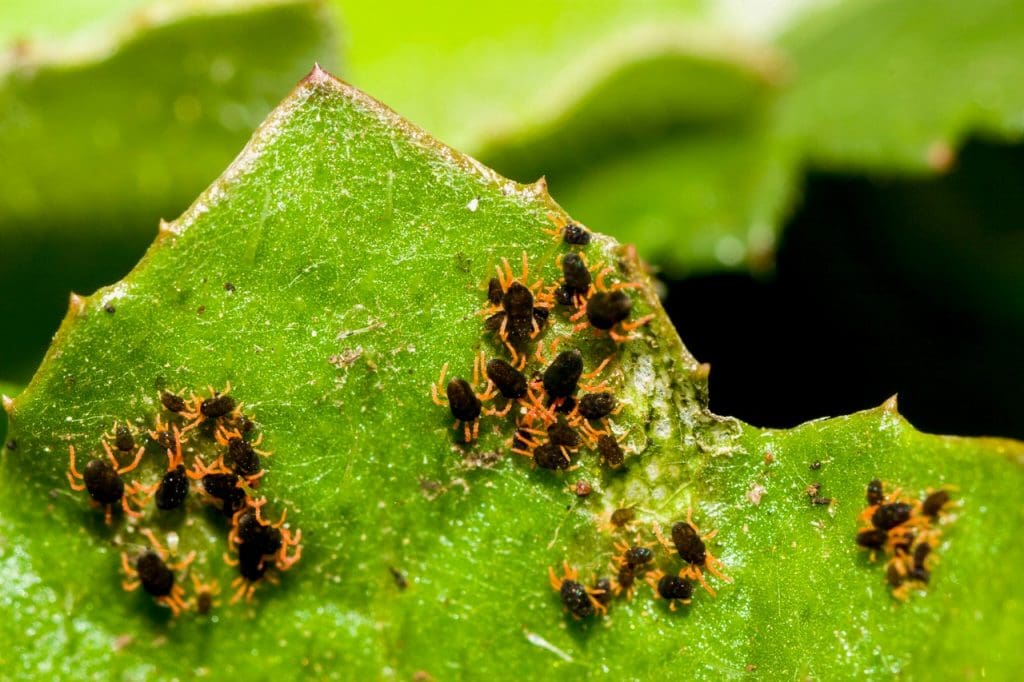
Red-legged earth mites.
INSECTICIDE-RESISTANT red-legged earth mites (RLEM; Halotydeus destructor) have been detected in Victoria for the first time, marking the most eastern point in Australia that resistance has been recorded in the pest.
With recent rains and cooler autumn temperatures expected to promote egg hatching of RLEM, experts supported by the Grains Research and Development Corporation (GRDC) are advising growers to pay close adherence to best-practice management strategies.
“While the level of resistance detected in Victoria is considered ‘low-level’, we can’t stress enough the importance of having a resistance management strategy at the forefront of RLEM control in south-eastern Australia,” cesar entomologist, Paul Umina, said.
While RLEM has high levels of resistance to insecticides for more than a decade in Western Australia, cases of insecticide resistance are now being detected beyond WA.
Since 2016, resistance to both synthetic pyrethroids, including bifenthrin and alpha-cypermethrin, and organophosphates, including omethoate and chlorpyrifos, has been detected in RLEM populations in numerous locations within South Australia.
RLEM has a wide appetite, feeding on a range of plants including but not limited to canola, clover, faba beans and lupins.
“If higher levels of insecticide resistance were to evolve to multiple chemistries and across larger areas, RLEM would be far more difficult to control on vulnerable establishing crops than what it is today in south-eastern Australia,” Dr Umina said.
Through a GRDC investment which supports scientific surveys and testing of suspect RLEM populations, cesar research scientist Aston Arthur collected RLEM populations in Victoria’s north in 2019, after an agronomist reported a spray failure with omethoate in 2018. The mites were collected from three paddocks in close proximity.
Back in the laboratory, Dr Arthur tested two organophosphate insecticides, omethoate and malathion, against these RLEM.
To determine if the test populations were expressing resistance, she ran a bioassay to compare their LC50 (the lethal concentration required to kill 50 per cent of the population) values to that of a known insecticide-susceptible population of RLEM.
Dr Arthur found at most a seven-fold increase when mites were tested against omethoate, and a 70-fold increase with malathion.
The test populations also underwent molecular testing to screen for resistance to synthetic pyrethroids. No synthetic pyrethroid resistance was found in any of the test populations.
Dr Umina said the ubiquity of the RLEM across many broadacre crops and pastures meant it was frequently exposed to insecticides and faced a high selection pressure to evolve resistance.
With sowing of winter crops and pastures already underway or starting for others, growers and advisers can source recommended best practice information on RLEM and resistance management in broadacre crops and pastures via two resources.
The first resource is the GRDC’s Redlegged earth mite best management practice guide – Southern, which can be found at https://grdc.com.au/redlegged-earth-mite-best-management-practice-guide-southern/.
Dr Umina said this guide was a useful tool to not only help minimise the incidence of RLEM but also to minimise the need for insecticide application.
The second resource is the Resistance management strategy for the redlegged earth mite in Australian grains and pastures, which can be found at https://grdc.com.au/FS-RLEM-Resistance-strategy.
This strategy outlines various chemical control approaches based on scenarios where there is no resistance, resistance to synthetic pyrethroids only, resistance to organophosphates only, or resistance to both synthetic pyrethroids and organophosphates.
RLEM may be mistaken for other crop-feeding mites. For help with mite identification, cesar’s PestBites episode on crop and pasture mite identification can be viewed at https://www.youtube.com/watch?v=y02DKvGfOkQ.
A GRDC podcast featuring Professor Ary Hoffman from the University of Melbourne discussing the evolution of pesticide resistance in RLEM can be found at https://grdc.com.au/news-and-media/audio/podcast/redlegged-earth-mite-a-pesticide-resistance-evolution.
Alongside cesar, project partners in this GRDC investment are CSIRO, the University of Melbourne, and the WA Department of Primary Industries and Regional Development.
Source: GRDC

HAVE YOUR SAY